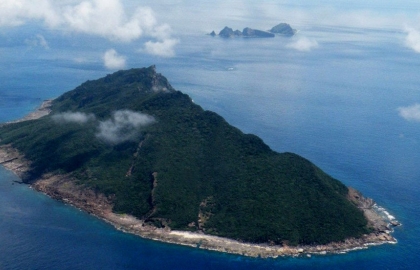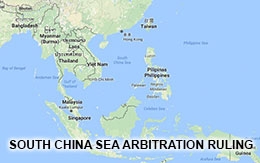China’s ‘New Thinking’ of the East China Sea Dispute
Recent developments in the East China Sea foreshadow a long-term trend of confrontation between the two great Asian powers which, if not properly managed, could upset regional stability in a catastrophic manner.

Ever since the normalisation of diplomatic ties between China and Japan forty-five years ago, their territorial disputes in the East China Sea have never occupied such a prominent place in the bilateral relationship like today. For Beijing, protecting China’s territorial sovereignty and maritime rights and interests over the disputed Diaoyu/Senkaku Islands has now assumed an unprecedented importance even at the expense of the overall Sino-Japan relationship. Recent developments in the East China Sea foreshadow a long-term trend of confrontation between the two great Asian powers which, if not properly managed, could upset regional stability in a catastrophic manner.
Continuing tensions
The year of 2017 marks the 45th anniversary of diplomatic normalisation between Beijing and Tokyo. There are, however, no assuring signs of real improvements in the lately fraught bilateral relationship. Instead, persistent tensions in the East China Sea indicate that the bilateral relationship is going to get worse before it can get better.
On April 25 2017, Japan’s Foreign Ministry tabled its annual Diplomatic Bluebook to a Cabinet meeting. Like in the last few years, the Bluebook expressed concerns about China’s perceived attempts to unilaterally change the status quo in the East China Sea, noting specifically the frequent ‘invasions’ of Chinese maritime law enforcement vessels into the Japanese territorial waters surrounding the disputed Islands in the preceding year. In response, a Chinese Foreign Ministry spokesperson restated China’s indisputable sovereignty over the Islands, describing activities of Chinese maritime agencies in the disputed waters as ‘reasonable and legitimate’ and urging Japan stop making new disruptions to the bilateral relationship. Two months earlier, Beijing also voiced its strong displeasure against the comments made by US Secretary of Defence, James Mattis, in Tokyo that the Article 5 of US-Japan Security Treaty would cover the disputed Diaoyu/Senkaku Islands. Shortly after Mattis’ statement, Beijing reportedly sent three Chinese Maritime Surveillance (CMS) ships into the 12 nautical mile territorial waters of the disputed islands to assert China’s sovereignty.
As a recent commentary by the Asia Maritime Transparency Initiative (AMTI) of the Centre for Strategic and International Studies at Washington observed warily, both Beijing and Tokyo were continuously taking actions to assert their territorial claims, building up a slow-moving crisis in the East China Sea which could escalate into an uncontrollable military crisis between the world’s second and third largest economies. Similarly, a commentary published in China’s nationalistic newspaper Global Times earlier this year warned that given the current tensions in the East China Sea, China and Japan could be just one step away from military conflicts.
Tougher Chinese stances
From Beijing’s point of view, the current tensions in the East China Sea have been entirely caused by Japan’s perceived provocative decision to nationalise three of the disputed islands in September 2012. While the Japanese government described its action as a pre-emptive, cautious measure to prevent ultra-nationalistic Mayor of Tokyo Shintaro Ishihara from acquiring and developing the islands, Beijing perceived the move as a deliberate and well-calculated tactics to strengthen Japan ‘s ‘Legal Status’ over the disputed islands. Perceiving Japan’s move as an unacceptable unilateral change to the status quo of the long-running dispute, Beijing has thus responded in an unprecedentedly tough manner. Consequently, Beijing’s approach towards the territorial dispute has changed fundamentally in a number of aspects.
Firstly, whereas in the past Beijing asserted its sovereignty largely through diplomatic protests, mass anti-Japanese demonstrations, and temporary cut-off of high-level engagements, since 2012 it has begun to directly contest Japan's long standing physical control of the disputed areas by deploying Chinese CMS vessels to regularly patrol the territorial waters of the disputed areas. It also established an Air Defence Identification Zone (ADIZ) in the East China Sea overlapping with Japan’s ADIZ and patrolled the relevant airspace with military and maritime surveillance aircrafts. Such activities fundamentally changed the status quo of the disputed areas, effectively creating a new reality of ‘dual administration’ of the disputed area.
Secondly, its increasingly tough stance over the last five years has demonstrated a long-term and increasingly well-coordinated proactive strategy to shape the development of the dispute in China’s favour. When tensions erupted in the East China Sea in the past, Beijing acted in an ad hoc and reactive manner, seeking short-term solutions and then shelving the dispute. Since 2012, Beijing has not only sought to create an overlapping administration of the disputed areas, but also taken constant, though incremental, measures that would shift the balance of control in the disputed areas to its favour. For example, in August 2016 China deployed 23 CMS vessels into the territorial sea of the disputed islands, a substantial increase than in previous months, causing significant concerns and protests on the part of the Japan. In July 2016, it was reported that a Chinese Navy warship for the first time entered into the territorial sea of the Diaoyu/Senkaku Islands. Chinese fight jets and maritime surveillance planes have also flown over air space near and in the disputed territory in greater frequencies, with the number of Japanese fight jet scrambling against Chinese aircraft rose to 851 times in FY2016 from 571 times in FY2015 and just 96 in FY2010.
Thirdly, China’s unprecedented toughness and assertiveness in the East China Sea also indicate its changing perception of the salience of the territorial dispute in the overall bilateral relations. Whereas in the past Beijing tended to prioritise the overall stability of the bilateral relationship over the maritime territorial disputes, its recent actions suggest a determination to defend China’s perceived maritime interests and territorial sovereignty even if at the expenses of the Sino-Japan relationship.
Chinese perceptions
Despite widespread external concerns of growing Chinese assertiveness in the East China Sea, Chinese analysts have generally perceived China’s increasingly tough actions as entirely justified if not overdue. For many Chinese analysts, recent frictions in the East China Sea have been fundamentally caused by the rise of the ‘right-wing’ revisionist political force in Japan’s domestic politics. There is a growing consensus among Japan watchers in Beijing that Japan in recent years, especially the Abe government, is decidedly pursuing a revisionist agenda, retreating from its stance on historical issues and seeking more assertive and potentially militaristic external policies.
Chinese policy-makers and analysts also see current problems in the bilateral relationship a fall-out of Japan’s increased reluctance to accept, and even hostility towards, China’s rise. They believe that Japan has increasingly seen China’s rise as a threat and perceived China as a strategic rival. Thus, in Beijing’s view, Japan is overtly adopting a confrontational approach to the bilateral relationship. As Chinese Foreign Minister, Wang Yi, stated in a press conference at China’s annual People’s Congress in March 2016, ‘As far as China-Japan relations are concerned, the underlying problem is that some politicians in Japan have the wrong perception about China. Do they view a growing China as a friend or a foe, a partner or an adversary? The Japanese side needs to give serious thought to this question and make the right choice.’
Chinese analysts also see the support of US to Japan as an important cause of Tokyo’s perceived growing provocative actions against China. Many Chinese analysts, however, are suspicious of the credibility of US commitments to defend Japan in the East China Sea dispute. Such a view has been further reinforced by US Present Trump’s conflicting statements on the US alliances. A prominent Chinese Japan watcher noted recently that ‘Trump may blackmail Tokyo for the latter's cost for US military protection and the US may reach a consensus with China over developing a constructive relationship, making Japan an abandoned pawn of Washington.’
While Beijing felt compelled to respond resolutely to the perceived Japanese provocations, its unprecedentedly tough stance has also been driven by a growing confidence of a shifting balance of power between the two countries to China’s favour. With China’s growing economic strength and its rapidly expanding maritime power, Chinese policy-makers and analysts generally believe that China can afford to, and should maintain, a firm stance in the territorial disputes against Japan’s perceived encroachment of China’s maritime interests and sovereignty.
Uncertainties ahead
In a fundamental sense, current tensions in the disputed islands reflect a symptom rather than causes of the increasingly problematic Sino-Japanese relations. Amidst China’s growing power, the unresolved historical feuds, bitterly contested territorial disputes, and changes in Japanese domestic politics, the bilateral relationship would face tremendous challenges and difficulties to manage in the years ahead. China’s newfound tough assertiveness in the East China Sea is unlikely to change. Instead, in the context of its growing power and a strongly nationalistic society, Beijing’s willingness and capability to take assertive actions to defend its perceived sovereignty and maritime rights will only grow stronger. Having said that, Beijing has recognised that the disputes can’t be solved anytime soon. China's current actions have largely been designed to deter more proactive actions on the part of Japan, deny its sole administration of the area, to force it to recognise the dispute, and gradually bolster China’s presence in the disputed areas. Given this, it can be expected that the tension in the East China Sea would be there for some time.
Dr Jian Zhang is an associate professor in International and Political Studies, UNSW Canberra at the Australian Defence Force Academy, the University of New South Wales in Australia. The opinions expressed in this article are the author's own and do not reflect the views of any institutions.










